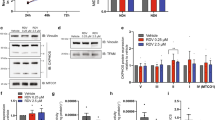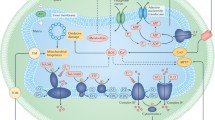Abstract
Nucleoside reverse transcriptase inhibitor (NRTI)-induced cardiomyopathy has been suggested to reflect mitochondrial targets of drug toxicity. The prevailing hypothesis is that, through structural mimicry, the NRTIs are mistaken as substrates for DNA polymerase and incorporated into replicating DNA, where they cause truncation of the elongating strand. Although there exist five forms of nuclear DNA polymerase, mitochondria possess solely DNA polymerase-γ (pol-γ), which is a preferred target for most NRTIs. Consequently, mitochondria are particularly susceptible to inhibition of DNA replication by the NRTIs, which is consistent with the phenotype of mitochondrial depletion and metabolic failure in affected patients. However, the DNA pol-γ hypothesis by itself fails to explain the entire array of metabolic deficiencies associated with NRTI-induced disorders. In this article, we review the published literature regarding the direct effects of NRTIs on various mitochondrial targets and suggest the possibility that the initiating event in NRTI-induced cardiomyopathy is a direct mitochondrial toxicity rather than inhibition of mitochondrial DNA pol-γ. The goal of this review is to encourage a discussion of the cause of NRTI-induced mitochondrial cardiomyopathy to include a fresh consideration of all possible targets and integrating pathways that are involved in establishing mitochondrial bioenergetic fidelity and metabolic capacity in the affected myocardium.
Similar content being viewed by others
References
Yarchoan, R., Klecker, R., Weinhold, K., Markham, P., Lyerly, H., Durack, D., et al. (1986). Administration of 3′azido-3′deoxythymidine, an inhibitor of HTLV-III/LAV replication, to patients with AIDS or AIDS-related complex. Lancet 1:575–580.
Helbert, M., Fletcher, T., Peddle, B., Harris, J.R.W., and Pinching, A.J. (1988). Zidovudine-associated myopathy. Lancet 2:689–690.
Bessen, L., Greene, J., Louie, E., Seitzman, P., and Weinberg, H. (1988). Severe polymyositis-like syndrome associated with zidovudine therapy of AIDS and ARC. N. Engl. J. Med. 318:708.
Brinkman, K., ter Hofstede, H.J., Burger, D., Smeitink, J., and Koopmans, P. (1998). Adverse effects of reverse transcriptase inhibitions: mitochondrial toxicity as common pathway. AIDS 12:1735–1744.
Kakuda, T.N. (2000). Pharmacology of nucleoside and nucleotide reverse transcriptase inhibitor-induced mitochondrial toxicity. Clin. Ther. 22:685–708.
Lewis, W. and Dalakas, M.C. (1995), Mitochondrial toxicity of antiviral drugs. Nat. Med. 1:417–422.
Lewis, W., Copeland, W.C., and Day, B.J. (2001). Mitochondrial DNA depletion, oxidative stress, and mutation: mechanisms of dysfunction from nucleoside reverse transcriptase inhibitors. Lab. Invest. 81:777–790.
Barazzoni, R., Short, K.R., and Nair, K.S. (2000). Effects of aging on mitochondrial DNA copy number and cytochrome c oxidase gene expression in rat skeletal muscle, liver, and heart. J. Biol. Chem. 275:3343–3347.
Sogl, B., Gellissen, G., and Wiesner, R.J. (2000). Biogenesis of giant mitochondria during insect flight muscle development in the locust, Locusta migratoria: transcription, translation and copy number of mitochondrial DNA. Eur. J. Biochem. 267:11–17.
Dalakas, M.C., Illa, I., Pezeshkpour, G.H., Laukaitis, J.P., Cohen, B., and Griffin, J.L. (1990) Mitochondrial myopathy caused by long-term zidovudine therapy. N. Engl. J. Med. 322:1098–1105.
Tang, Y., Schon, E.A., Wilichowski, E., Vasquez-Memije, M.E., Davidson, E., and King, M.P. (2000). Rearrangements of human mitochondrial DNA (mtDNA): new insights into the regulation of mtDNA copy number and gene expression. Mol. Biol. Cell. 11:1471–1485.
Pereira, L.F., Oliveira, M.B.M., and Carnieri, E.G.S. (1998). Mitochondrial sensitivity to AZT. Cell Biochem. Funct. 16:173–181.
Lamperth, L., Dalakas, M.C., Dagani, F., Anderson, J., and Ferrari, R. (1991). Abnormal skeletal and cardiac muscle mitochondria induced by zidovudine (AZT) in human muscle in vitro and in an animal model. Lab. Invest. 65:742–751.
Szabados, E., Fischer, G.M., Toth, K., Csete, B., Nemeti, B., Trombitas, K., et al. (1999). Role of reactive oxygen species and poly-ADP-ribose polymerase in the development of AZT-induced cardiomyopathy in rat. Free Radic. Biol. Med. 26:309–317.
Cazzalini, O., Lazze, M.C., Lamele, L., Stivala, L.A., Bianchi, L., Vaghi, P., et al. (2001). Early effects of AZT on mitochondrial functions in the absence of mitochondrial DNA depletion in rat myotubes. Biochem. Pharmacol. 62:893–902.
Modica-Napolitano, J.S. (1993). AZT causes tissue-specific inhibition of mitochondrial bioenergetic function. Biochem. Biophys. Res. Commun. 194:170–177.
Benbrik, E., Chariot, P., Bonavaud, S., Ammi-Said, M., Frisdal, E., Rey, C., et al. (1997). Cellular and mitochondrial toxicity of zidovudine (AZT), didanosine (ddI), and zalcitabine (ddC) on cultured human muscle cells. J. Neurol. Sci. 149:19–25.
Pan-Zhou, Z.-R., Cui, L., Zhou, X-J., Sommadossi, J.-P., and Darley-Usmar, V.M. (2000). Differential effects of antiretroviral nucleoside analogs on mitochondrial function in HepG2 cells. Antimicrob. Agents Chemother. 44: 496–503.
Atlante, A. and Passarella, S. (1998). AZT side effect on mitochondria does not depend on either inhibition of electron flow or mitochondrial uncoupling. Int. J. Mol. Med. 1:601–603.
Gerschenson, M., Erhart, S.W., Paik, C.Y., Claire, M.C.S., Nagashima, K., Skopets, B., et al. (2000). Fetal mitochondrial heart and skeletal muscle damage in Erythrocebus patas monkeys exposed in utero to 3′-azido'-3′-deoxythymidine. AIDS Res. Hum. Retroviruses 16:635–644.
Hobbs, G.A., Keilbaugh, S.A., Reif, P.M., and Simpson, M.V. (1995). Cellular targets of 3′-azido-3′-deoxythymidine: an early (non-delayed) effect on oxidative phosphorylation. Biochem. Pharmacol. 50:381–390.
Keilbaugh, S.A., Hobbs, G.A., and Simpson, M.V. (1997). Effect of 2′,3′-deoxycytidine on oxidative phosphorylation in the PC12 cell, a neuronal model. Biochem. Pharmacol. 53:1485–1492.
Valenti, D., Atlante, A., Barile, M., and Passarella, S. (2002). Inhibition of phosphate transport in rat heart mitochondria by 3′-azido-3′-deoxythymidine due to stimulation of superoxide anion mitochondrial production. Biochem. Pharmacol. 64:201–206.
Genova, M.L., Ventura, B., Giuliano, G., Bovina, C., Formiggini, G., Castelli, G.P., et al. (2001). The site of production of superoxide radical in mitochondrial Complex I is not a bound ubisemiquinoe but presumably ironsulfur cluster N2. FEBS Lett. 505:364–368.
Sutliff, R.L., Dikalov, S., Weiss, D., Parker, J., Raidel, S., Racine, A.K., et al. (2002). Nucleoside reverse transcriptase inhibitors impair endothelium-dependent relaxation by increasing superoxide. Am. J. Physiol. Heart Circ. Physiol. 283:H2363-H2370.
Collier, A.C., Helliwell, R.J.A., Keelan, J.A., Paxton, J.W., Mitchell, M.D., and Tingle, M.D. (2003). 3′-A zido-3′-deoxythymidine (AZT) induces apoptosis and alters metabolic activity in human placenta. Toxicol. Appl. Pharmacol. 192:164–173.
Elimadi, A., Morin, D., Albengres, E., Chauyet-Monges, A.-M., Allain, V., Crevat, A., et al. (1997). Differential effects of zidovudine and zidovudine triphosphate on mitochondrial permeability transition and oxidative phosphorylation. Br. J. Pharmacol. 121:1295–1300.
Sales, S.D., Hoggard, P.G., Sunderland, D., Khoo, S., Hart, C.A., and Back, D.J. (2001). Zidovudine phosphorylation and mitochondrial toxicity in vitro. Toxicol. Appl. Pharmacol. 177:54–58.
Wada, S., Tsuda, M., Sekine, T., Cha, S.H., Kimura, M., Kanai, Y., et al. (2000). Rat multispecific organic anion transporter 1 (rOAT1) transports zidovudine, acyclovir, and other antiviral nucleoside analogs. J. Pharmacol. Exp. Ther. 294:844–849.
Masini, A., Scotti, C., Caligaro, A., Cazzalini, O., Stivala, L.A., Bianchi, L., et al. (1999). Zidovudine-induced experimental myopathy: dual mechanism of mitochondrial damage. J. Neurol. Sci. 166:131–140.
Chen, Q., Vazquez, E.J., Moghaddas, S., Hoppel, C.L., and Lesnefsky, E.J. (2003). Production of reactive oxygen species by mitochondria: central role of complex III. J. Biol. Chem. 278:36027–36031.
Herzberg, N.H., Zorn, I., Zwart, R., Portegies, P., and Bolhuis, P.A. (1992). Major growth reduction and minor decrese in mitochondrial enzyme activity in cultured human muscle cells after exposure to zidovudine. Muscle Nerve 15:706–710.
Freyssenet, D., DiCarlo, M., Escobar, P., Grey, J., Schneider, J., and Hood, D.A. (1999). Zidovudine (AZT) induced alterations in mitochondrial biogenesis in rat striated muscles. Can. J. Physiol. Pharmacol. 77:29–35.
McCurdy, D.T. and Kennedy, J.M. (1996). Skeletal muscle mitochondria from AZT-treated rats have a diminished response to chronic electrical stimulation. J. Appl. Physiol. 81:326–334.
McCurdy, D.T. and Kennedy, J.M. (1998). AZT decreases rat myocardial cytochrome oxidase activity and increases b-myosin heavy chain content. J. Mol. Cell. Cardiol. 30: 1979–1989.
Sommadossi, J.P., Carlisle, R., and Zhou, Z. (1989). Cellular pharmacology of 3′-azido-3′-deoxythymidine with evidence of incorporation into DNA of human bone marrow cells. Mol. Pharmacol. 36:9–14.
Weidner, D.A. and Sommadossi, J.P. (1990). 3′-Azido-3′-deoxythymidine inhibits globin gene transcription in butyric acid-induced K-562 human leukemia cells. Mol. Pharmacol. 38:797–804.
Agarwal, R.P. and Olivero, O.A. (1997). Genotoxicity and mitochondrial damage in human lymphocytic cells chronically exposed to 3′-azido-2′,3′-deoxythymidine. Mutat. Res. 390:223–231.
Martin, J.L., Brown, C.E., Matthews-Davis, N., and Reardon, J.E. (1994). Effects of antiviral nucleoside analogs on human DNA polymerases and mitochondrial DNA synthesis. Antimicrob. Agents Chemother. 38:2743–2749.
Cheng, Y.C., Gao, W.Y., Chen, C.H., Vazquez-Padua, M., and Starnes, M.C. (1990). DNA polymerases versus HIV reverse transcriptase in AIDS therapy. Ann. NY Acad. Sci. 616:217–223.
Yamaguchi, T., Katoh, I., and Kurata, S.-I. (2002). Azidothymidine causes functional and structural destruction of mitochondria, glutathione deficiency and HIV-1 promoter sensitization. Eur. J. Biochem. 269:2782–2788.
Barile, M., Valenti, D., Passarella, S., and Quagliariello, E. (1997). 3′-Azido-3′-deoxythymidine uptake into isolated rat liver mitochondria and impairment of ADP/ATP translocator. Biochem. Pharmacol. 53:913–920.
Barile, M., Valenti, D., Hobbs, G.A., Abruzzese, M.F., Keilbaugh, S.A., Quadgliariello, E., et al. (1994). Mechanisms of toxicity of 3′-azido-3′-deoxythymidine: its interaction with adenylate kinase. Biochem. Pharmacol. 48:1405–1412.
Valenti, D., Barile, M., Quagliariello, E., and Passarella, S. (1999). Inhibition of nucleoside diphosphate kinase in rat liver mitochondria by added 3′-azido-3′-deoxythymidine. FEBS Lett. 444:291–295.
Bourdais, J., Biondi, R., Sarfati, S., Guerreiro, C., Lascu, I., Janin, J. et al. (1996). Cellular phosphorylation of anti-HIV nucleosides. J. Biol. Chem. 271:7887–7890.
Moraes, C.T. (2001). What regulates mitochondrial DNA copy number in animal cells?. Trends Genet. 17:199–205.
D’Amati, G., and Lewis, W. (1994). Zidovudine causes early increses in mitochondrial ribonucleic acid abundance and induces ultrastructural changes in cultured mouse muscle cells. Lab. Invest. 71:879–884.
Gerschenson, M., Nguyen, V.T., Claire, M.C.S., Harbaugh, S.W., Harbaugh, J.W., Proia, L.A., et al. (2001). Chronic stavudine exposure induces hepatic mitochondrial toxicity in adult Erythocebus patas monkeys. J. Hum. Virol. 4: 335–342.
Georges, B., Galland, S., Rigault, C., Borgne, F.L., and Demarquoy, J. (2003). Beneficial effects of 1-carnitine in myoblastic C2C12 cells: interaction with zidovudine. Biochem. Pharmacol. 65:1483–1488.
Author information
Authors and Affiliations
Corresponding author
Rights and permissions
About this article
Cite this article
Lund, K.C., Wallace, K.B. Direct, DNA pol-γ-independent effects of nucleoside reverse transcriptase inhibitors on mitochondrial bioenergetics. Cardiovasc Toxicol 4, 217–228 (2004). https://doi.org/10.1385/CT:4:3:217
Revised:
Accepted:
Issue Date:
DOI: https://doi.org/10.1385/CT:4:3:217




